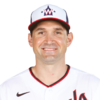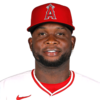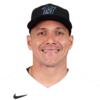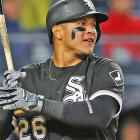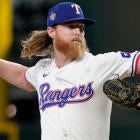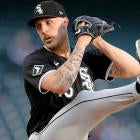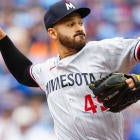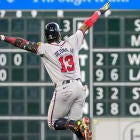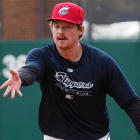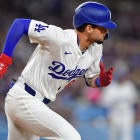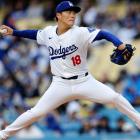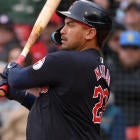It's an ambiguous headline, I know. What qualifies as a "breakthrough," how would I go about "buying" it, and does "fully" eliminate the possibility of "partially?"
Some ideas work in a more nebulous way, and piling on too many rules and provisos only risks suffocating them, but in this case, I'd like to explain my thought process so that I'm not the reason you do something reckless and/or stupid.
These hitters have all been amazing so far -- so good that the idea of any of them going unowned is downright laughable. Somebody should be taking advantage of their production right now, and if that somebody is you, it's not a bad thing.
But in the interest of prolonging the benefit and maximizing the payoff of a clutch waiver claim (or in some cases, draft pick), it's worth assessing the legitimacy and sustainability of each performance.
Because sometimes, a player just gets hot. At the beginning of the year, with zero as the starting point, it can seem like more -- and in the case of a waiver claim, you make the move just in case it is, as we're doing now with Scott Schebler, Justin Smoak and Justin Bour -- but it's usually not. And when you realize it, the joy you're feeling now will turn to regret.
But I can live with regret from inaction more than I can from proaction -- you know, the whole do-no-harm thing that doctors swear to -- which I think gets lost in most sell-high discussions. There's a case to be made for every one of these players as well, so if you don't show your miracle pickup the appreciation it deserves, you risk shooting yourself in the foot.
In other words, my goal here isn't to convince you to sell these players while you still can, but to remind you that it's OK to sell them if the right offer comes along -- and by "right offer," I mean someone willing to take on all the risk by paying face value for an unproven product.
Yes, these hitters have all been amazing so far, but if the return is also amazing, what do you have to lose?
There was some talk early that Daniel Murphy's influence as leader of the fly-ball revolution was igniting Zimmerman's breakthrough, but the passage of time has revealed Zimmerman to be a hitter who still puts the ball on the ground close to 45 percent of the time. That ratio is much like his early years, when he was indeed considered a Fantasy asset, but not the monster we're seeing now.
So maybe regression for him, with this hot start, still looks like a .300 batting average and 30 home runs. Not bad, right? But if the best explanation we have for his breakthrough is that he's finally healthy after three injury-plagued years, can we assume it'll last at age 32? Will he even get the at-bats for 30 homers, as slowed as that pace would be?
Miguel Sano is a distant first in average exit velocity, and no hitter comes close to his 3.9 soft contact percentage on FanGraphs (Bryce Harper, just for the sake of comparison, is 13.8). So the talent is evident, and I make a rule not to bet against talent. But trading him now, when he's presumed to have broken out, isn't betting against him. It's cashing in.
No player who has struck out 200 times in a season has hit better than .262, and most have hit around .220. Sano is on pace for a record 235 strikeouts, so between that and his absurd .463 BABIP, you should expect the batting average to come down. He may come closer to the .260 mark than not, given how hard he hits the ball, but he's aspiring to be what Chris Davis has been the last few years -- i.e., the most high-variance of players.
Just when Avisail Garcia looks like he's slowing down, his batting average slipping all the way to (gasp!) .336, he goes and turns in his most productive week of the season, homering twice Saturday. This charade has already lasted longer than anyone would have expected, which makes it deserving of a longer look, but it's a fine line he's walking statistically. He has one of the lowest walk rates of any qualifying hitter, which means his production is entirely tied to batting average, and right now, that's built on an unsustainable .402 BABIP.
Maybe he can keep hitting over .300 if the power gains are legit -- and for a strapping 25-year-old, that's certainly plausible -- but his fly-ball rate suggests he's still not great at elevating the ball, which again gives him a thin margin for error. He may well be the hitter Adam Jones was in his prime, or he may be another Melky Cabrera.
Like Garcia, Dickerson continues to laugh in the face of an above-.400 BABIP, putting together one of his best stretches of the season with five home runs over five consecutive two-hit games. He's looking like the hitter we all hoped he'd be with the Rockies, and so the pressure to endorse him utterly and completely is mounting.
But he's still not the hitter he was with the Rockies, his 19.2 percent line-drive rate more resembling his 17.5 percent mark from last year, when he hit .245, than the 27-ish percent marks he put up in Colorado. Plus, his soft contact rate is actually up from a year ago, according to FanGraphs, and while his hard contact rate is also up, it's not like it puts him among the league leaders. Fly-ball revolution? Nope, not Dickerson. He has actually traded last year's 45.0 percent fly-ball rate (encouraging!) for a 42.3 percent ground-ball rate (discouraging).
So if he's striking the ball in a way that can only be described as average, why should we believe any sort of transformation has taken place?
Mark Reynolds was always an all-or-nothing hitter prior to joining the Rockies last year, so he surprised us by hitting just 14 home runs in the league's most hitter-friendly environment. But he also hit a career-best .282. The peripherals painted him as a hitter who stopped selling out for power, drastically reducing his strikeout and fly-ball rates to make him not such an easy out. It was a questionable transformation, but one he obviously felt he needed to keep his career alive.
So now we're seeing the best of both worlds, right? Well, the strikeout rate is down even more, which can only be a good thing, but so is the fly-ball rate, ranking among the 35 lowest in the game. And in fact, his ground-ball rate is about 10 percent higher than his career mark. He has leaned into the adjustments that took away his power, and yet suddenly it's back? Something doesn't add up there.
Kevin Pillar has so far done his best A.J. Pollock impression, performing at a 22-homer, 25-steal pace with a bunch of doubles and a batting average that seems fairly sustainable judging by his .331 BABIP. He got some attention for a 12-homer 25-steal season back in 2015, and I've always felt like he should hit for average given his low strikeout rate, which is the 22nd-best in baseball this year. But this level of production goes far beyond anything I imagined for the 28-year-old.
He has maintained better than a .295 batting average for a month straight now, so the biggest question is whether or not the power gains are legit (which are partially fueling the higher batting average), and judging by the quality of contact, it's fair to wonder. His fly-ball rate is in line with his career mark, and his average exit velocity is only middle of the pack. Given that he doesn't walk much and isn't going to run at a Billy Hamilton clip, he's pretty fringy if he regresses to the hitter he was two years ago.
Though he had a couple double-digit home runs season in the minors, Chris Owings isn't a traditional power hitter, but the 18-homer pace isn't even the most questionable aspect of his performance. Shoot, it's pretty tame in a year when 102 players are on pace for 20 or more. But if you can't expect a big home run total from a guy projected to walk just 29 times, he better contend for a batting title.
So far Owings is and in a way that kind of works. His 27.5 percent line-drive rate is the fourth-highest in baseball, which makes his .393 BABIP, while still too high, not as outlandish as it initially appears.
But Owings is no stranger to high line-drive rates, boasting a 24.9 percent mark for his career (which would rank 17th this year), and the highest he has hit in any one season is .277. That came last year, when he actually had a lower strikeout rate than this year. So he may well need those 18 homers to flirt with a .300 batting average, and that's a big ask.
Of course, it's also a big ask to replace a shortstop doing anything halfway useful, and Owings at least has stolen bases going for him.
The inspiration for this piece, Aaron Altherr was the latest nobody to inspire a mad dash to the waiver wire, and I was right there with everybody else because, again, you have to take a chance on superlative production when it's free for the taking. But once it's in your possession, you can assess it with greater discernment and determine how to make the best use of it. In Altherr's case, it might be trading it, because we have no idea what to expect from the 26-year-old.
He was a toolsy prospect who showed some extra-base pop in a late-season call-up two years ago but ultimately hit just .241 and then was a disaster last year after missing four months with a wrist injury. Sure, it's reasonable to think the injury stalled his development, and his 6-foot-5 frame makes this sort of power breakthrough plausible as well. But we're kind of banking on it given his strikeout rate, which isn't as prohibitive as some on this list but requires a decent home run total to support even a .250-.260 batting average.
So what's the problem? He never hit more than 14 home runs in a minor-league season. His soft contact rate would be the 14th-highest in baseball if he had the at-bats to qualify. Among the 129 hitters with at least five home runs, his are the ninth-shortest on average, according to ESPN Home Run Tracker. His fly-ball rate is about on the level of Mark Reynolds'. It's not the profile of a power, in other words, and Altherr doesn't have enough to fall back on if he's not a power hitter.







